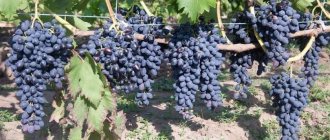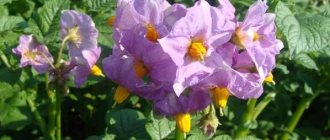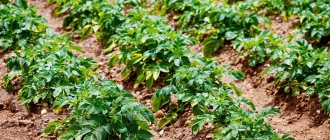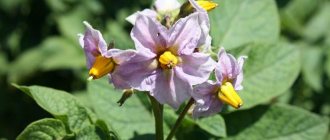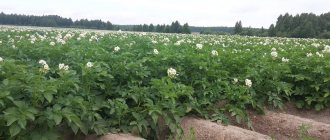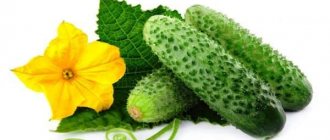Potato Nadezhda: variety description
These potatoes appeared thanks to the staff of the A. G. Lorch Potato Research Institute. It is not difficult to care for the plants; classical agricultural technology is mainly used, taking into account regional characteristics. The variety was included in the Russian Plant Register in 2009.
Ripening time and yield
Nadezhda is considered a mid-season potato; after the first shoots appear, it can be dug up within 90 days. The maximum yield was recorded at 345 c/ha according to the results of state tests.
What does the Nadezhda potato look like, which annually pleases with its harvest?
Disease resistance
The Nadezhda potato variety is well resistant to potato blight and striped mosaic. Resistance to late blight is average on tops, moderate on tubers. The only problem with this variety is its susceptibility to cyst nematodes.
Important! Timely prevention will help cope with the problem of diseases.
Characteristics of tubers
The potato variety Nadezhda, a characteristic whose reviews are mostly positive, has a lot of advantages. The bush is erect, the leaves are small, less often medium green, the waviness on them is barely noticeable. The flowers are bluish in color.
Blue flowering of potatoes - varietal trait
The tubers are elongated oval, the eyes are barely noticeable and small. The skin is light beige and the flesh is creamy. They weigh up to 160 g and contain more than 17% starch. Up to 90% of the harvest remains marketable, and 93% remains until spring.
What regions is it suitable for?
The variety is intended for planting in the Urals and central Russia, but can also be grown in more southern regions.
For your information! Nadezhda potatoes are undemanding in terms of climate; they can grow even in northern regions, the main thing is to regulate watering and prevent water from stagnating.
Taste qualities
Good taste characteristics are noted. Most often used for making chips and French fries. Suitable for use in any form. During heat treatment, the tubers do not crumble and crack slightly.
Video about the variety “Nadezhda”
Unfortunately, there is no video for this variety at the moment. We invite you to watch the video section of our website, where other videos about potatoes and other agricultural crops are posted. We and the entire farming community will be grateful if you send us your video or link about this variety from YouTube or any other video hosting service. If you see this message, it means that we have not yet been able to find a suitable video for this variety.
Similar articles:
Potatoes and all its varieties in detail here → Potato variety “Bonnie” - description characteristics reviews photo video
Potatoes and all its varieties in detail here → Potato variety “Batya” - description characteristics reviews photo video
Potatoes and all their varieties in detail here → Potato variety “Brook” - description characteristics reviews photos video
Potatoes and all their varieties in detail here → Potato variety “Bryansk New” - description characteristics reviews photos video
Potatoes and all their varieties in detail here → Potato variety “Bronnitsky” - description characteristics reviews photos video
The main advantages and disadvantages of the variety
In Nadezhda potatoes, according to the characteristics of the variety, the only significant drawback is considered to be instability to the golden nematode. And many more advantages have been noticed:
- medium and large tubers;
- high productivity;
- high keeping quality;
- good taste;
- Can be used for making chips;
- unpretentiousness in care and climatic conditions;
- cancer resistance.
Summer residents are noticing more and more positive qualities of Nadezhda potatoes, and resistance to most diseases allows them to grow natural potatoes with minimal or no chemical use or even without it at all.
Potato variety Nadezhda
Nadezhda is a mid-season potato variety (Solanum tuberosum) of Russian selection.
Developed by specialists from the All-Russian Research Institute of Potato Farming named after A. G. Lorch. Obtained by crossing the variety KZ 1151 and the numbered hybrid 128−6. In 2009, it was included in the state register of plants of the Russian Federation. Approved for cultivation in two regions of the country: Central (Bryansk, Vladimir, Tula, Smolensk, Ivanovo, Moscow, Kaluga, Ryazan regions) and Ural (Orenburg, Kurgan, Chelyabinsk regions and the Republic of Bashkortostan). Excellent for processing into crispy potatoes. Valued for its ease of care and good productivity in various climatic conditions. The time from the appearance of full shoots to ripening is 80−95 days.
The plant is of an intermediate type, semi-erect. The leaves are small or medium-sized, intermediate in type, with medium wavy edges, green in color. The inner side of the corolla has a weak anthocyanin color, the proportion of blue is average.
In one Nadezhda nest, about 6-9 medium or large potatoes are formed. The weight of marketable tubers ranges from 96 to 162 grams. The tubers are elongated oval in shape. The peel is slightly mesh, light beige in color. The flesh is cream-colored. The eyes are small and shallow.
Marketable yield, based on the results of state tests of the variety, amounted to 192−348 c/ha, which is comparable to the Kolobok and Bronnitsky standards. The maximum amount of potatoes was collected in the Ivanovo region - 416 centners of tubers were obtained per hectare of area, 180 c/ha more than the results of Lugovskaya. Marketability 82−96%. Keeping quality is good, but not outstanding - 93%.
Our hero has good taste. The tubers boil well, crack when cooked, but do not lose their shape. The pulp is very tender, slightly mealy, not watery, with a very pleasant taste. Potatoes are best suited for baking, frying, and making mashed potatoes. But it is especially suitable for processing into chips and French fries, and is also suitable for making dry purees. And all this thanks to the very high starch content - 18-20%. The minimum amount is noted at 13.9%.
The variety is relatively undemanding to soil composition and can grow in different climatic conditions. It performs especially well in the Central region, on fertile, loose soils. In agricultural technology, plants are simple, do not require special care, except for the most standard measures - loosening the soil, hilling, treating pests and diseases, weeding, watering and fertilizing.
Nadezhda is resistant to cancer, banded and wrinkled mosaics. According to the originator, it is moderately resistant to the pathogen of late blight on tops and moderately resistant to tubers. Susceptible to golden cyst nematode, requires high-quality prevention.
This potato is valued by gardeners for its high stable yield, the ability of plants to adapt to different growing conditions, the good presentation of the tubers, their fairly early ripening, and excellent taste. Summer residents also highlight plant resistance to many diseases, making the variety suitable for organic farming without the use of “chemistry”.
One of the advantages of Nadezhda is the high starch content in the pulp, which makes it suitable for processing into chips. And, of course, this affects the taste - it is very rich and pleasant.
Planting and growing potatoes of the Nadezhda variety
To begin the planting procedure, it is necessary to prepare the site in the fall. To do this, they dig it up and apply fertilizer. Planting is carried out after a stable temperature has been established and the earth has warmed up to 10 ° C.
Preparing for landing
2 weeks before planting, you need to take the prepared Nadezhda potato tubers outside for germination and hardening. The sprouts begin to actively grow, and the variety will better withstand possible cold snaps.
Note! In the spring, the area is dug up again a month before planting potatoes so that the soil is saturated with oxygen. In addition, fertilizers applied in the fall are mixed with the soil again, and nutrients are distributed more evenly.
Soil requirements
A lot depends on the quality of the land, but not everything. Nadezhda potatoes easily adapt to the soil composition and weather conditions of the region. A gardener just needs to add organic matter in the fall and a handful of wood ash when digging holes. The rest should be based on the composition of the soil and regional characteristics.
Diseases and pests: how to fight
Since the golden cyst nematode poses the greatest danger to Nadezhda potatoes, special attention should be paid to its prevention. These microscopic organisms cannot be seen with the naked eye, but the plant stops growing and the roots begin to gradually die. In the case of potatoes, tubers do not form and rot directly in the ground. At the same time, the foliage loses its brightness of color.
Since it is quite difficult to influence an emerging pest, and it multiplies at an incredible speed, disease prevention becomes important. For this:
- It is not recommended to plant potatoes in one area for more than two years in a row;
- in risk areas, use nematode-resistant varieties;
- apply nitrate fertilizers, it is best to use urea by digging it into the soil;
- plant only healthy tubers in the ground; there should be no damage or signs of disease on them;
- disinfect planting material with a manganese solution.
The nematode does not tolerate plants such as marigolds, calendula, all plants of the legume family and rye. In addition, by planting them on your site, you can significantly improve the quality of the soil. Strong chemicals are used when there is a large number of pests in the soil; you can try thionazine.
Important! It is easier to fight insects and the Colorado potato beetle using fungicides that are sold in specialized stores.
Nadezhda potatoes are a tasty and productive root crop that does not require special care. It can be grown in almost all regions of Russia, and the plant itself will adapt to the climate and weather conditions. Preventing diseases will help you get a large and tasty potato harvest, and proper storage will provide you with food for the whole winter.
How to properly care for the variety
One of the advantages of the Nadezhda potato variety is its ease of care. Standard agricultural techniques - watering, weeding and hilling - are sufficient. If necessary, treat with fungicides against pests. Nadezhda also responds well to fertilizing; most of all, potatoes of this variety prefer organic matter.
Features of watering
After planting, the potatoes should not be watered; it is enough to fill the hole with the tuber with soil and leave it alone for a week. During this time, the first shoots will appear, and then watering will be required.
During the growing season, it is recommended to water once a week, after flowering - once every two weeks. A month before harvesting, you should completely stop watering the bushes. This will allow the potatoes to quickly gain weight, strengthen the skin, and complete the ripening process.
Feeding and fertilizing
For the Nadezhda variety, preliminary autumn fertilization is very important. The plant responds well to wood ash, which can be diluted in an amount of 0.5 kg per bucket of water and watered with 0.5 liters of this mixture for each plant.
Spraying potatoes will protect against pests and diseases
To increase the size of tubers and their quantity, you can use superphosphate, which is added according to the instructions on the package.
Important! You should not put manure directly into the hole with the tuber; the potatoes will burn and will not produce a harvest.
Hilling and weeding
Since Nadezhda’s ripening occurs towards the end of summer, weeds can overpower the garden plant all season long; they must be weeded. You can use mulching, which will retain moisture and prevent weeds from germinating.
Hilling is also a must for potatoes. The first time it is carried out when the bushes reach 10 cm or more. Then as needed, and also without fail after watering or rain.
For your information! When water dries on the surface of the earth, it forms a crust that prevents the tubers from breathing; hilling and loosening can save the situation.
Potatoes "Gala": description of the variety, photos and reviews
“Gala” is a popular potato variety included in the State Registers of Russia (in 2008) and Belarus (in 2011). The variety was developed by specialists from the German breeding and seed company Norika (full name – Norika Nordring-Kartoffelzucht-und Vermehrungs-GmbH) and patented by the German company Norex Norika Exportgesellschaft mbH; Agro (village of Uporovo, Tyumen region) was also declared among the originators when registering in Russia.
Potato variety "Gala" is well adapted to various soil and climatic conditions; it is recommended for cultivation in the North-Western, Central and Volga-Vyatka regions, but is successfully cultivated almost throughout Russia, Belarus and Ukraine. It has earned great popularity among amateur gardeners and professional vegetable growers, who appreciated the suitability of this variety for mechanized harvesting, washing, packaging and packaging. Thanks to the excellent taste of the tubers, their uniform presentation and good keeping quality, potatoes are in consistently high consumer demand.
Let's summarize the main characteristics of the variety in a table:
"Gala" refers to the table varieties of medium-early ripening. The growing season before the onset of technical ripeness is 70-80 days. Young tubers reach a size sufficient for consumption by the 40th day after germination.
Potato bushes are medium-sized, semi-erect. Stems are medium thick; the leaves are large, green, matte, with moderate wavy edges. The inflorescences are small, with a small number of white flowers. Anthocyanin coloring on the inside of the flower, stems and leaf veins is absent or very weak.
Anthocyanins are plant pigments that color the fruits and seeds of plants, their generative (flowers, pollen) and vegetative (stems, leaves, roots) organs in purple, blue, dark blue and violet colors.
Plants demonstrate friendly and uniform germination. The tops grow moderately, but close in rows quite quickly. You can see what plants look like during the flowering period in a potato field in the following video:
The tuber is of medium size, at the stage of technical ripeness it weighs about 70-120 g. The shape is elongated or round-oval, the ratio of length to diameter (shape index): 1/1.1-1.29. The peel is yellow, quite dense, with a smooth or slightly flaky (smooth mesh) surface. The eyes are small in number, small, and lie to a depth of 1-1.3 mm. The light sprout is distinguished by its ovoid shape and red-violet color at the base, with weak or medium density of pubescence.
Due to their small eyes, even shape and low susceptibility to black spot, the tubers are ideal for mechanical peeling. The pulp is dark yellow with a slight tendency to darken when raw. Potatoes “Gala” have a tasting rating of 5 points based on their taste characteristics. After cooking and other types of heat treatment, the tubers practically do not change color and do not crumble, maintaining a predominantly solid texture (A/B boilability type).
The nutritional value
The yellow color of the tubers indicates a large amount of carotene (provitamin A). The average content of nutrients in fruits is as follows:
Due to their high taste and preservation of the fiber structure, the purpose of tubers is universal: they are used for all types of processing. And due to the small amount of starch and the presence of vitamins, Gala potatoes are even recommended as a dietary food product.
Productivity
The variety is considered high-yielding, distinguished by a large number of tubers in one nest (10-16 pieces, and according to some sources up to 25) and their even size.
The marketable yield of young potatoes “Gala” on the 40th day after entry is about 150-170 c/ha, and at the stage of technical ripeness at the end of the growing season it is:
- in Russia the average is 220-263 c/ha (at the level of the Nevsky variety standard), the maximum is 390 c/ha (in the Vologda region);
- in Belarus, the average is 337 c/ha, the maximum is 568 c/ha (obtained in 2008 at the Molodechno Variety Testing Station).
The variety provides a commercial output of 71-94% of the total harvest. The shelf life is high - 89-96%, which ensures reliable transportation and long storage without loss of external and taste qualities.
Sustainability
The variety is resistant to mechanical damage to tubers, Colorado potato beetle invasions and a whole range of viral, fungal and bacterial diseases:
How to harvest and store crops
Harvest time occurs in mid or late August. It is worth collecting it only in dry weather, so that the potatoes remain clean and it takes as little time as possible to dry them.
Note! Potatoes harvested in the rain will not store well and will quickly rot.
Potatoes should be dug up after the bushes have drooped and turned completely yellow. A couple of weeks before harvesting, it is better to remove all tops from the area to reduce the likelihood of disease. They dig the potatoes, grabbing part of the soil slightly to the side of the bush, so as not to damage the tubers. Summer residents often use pitchforks; they are especially convenient on light soils. Thanks to them, the potatoes are less damaged and last longer.
Potatoes should be harvested in late August - early September
Storage features and shelf life of the Nadezhda variety
The Nadezhda potato variety stores well, the main thing is to remove all damaged and spoiled tubers before doing so. After the potatoes are dug, it:
- Lay out in one layer under a canopy to dry.
- Tubers intended for planting next year are laid to dry in the sun.
- Then all the potatoes are carefully sorted, discarding everything that is spoiled and not suitable for storage.
- Seed potatoes and for food should be stored separately, but the same conditions must be observed.
Possessor of unsurpassed taste - Nadezhda potatoes: description and characteristics of the variety
Potato Nadezhda is an unpretentious domestic potato with many positive qualities. The variety is optimal for industrial cultivation, has excellent taste and drought tolerance.
| Ripening time | Starch content, % | Weight of tubers, gr. | Number of tubers in a bush | Productivity, c/ha | Keeping quality, % | Peel color | Flesh color | Country of selection |
| Mid-season | 13,9-17,9 | 92-162 | 6-9 | 192-416 | 93 | Yellow | Cream | Russia (USSR) |
granada potatoes description
- Potatoes Granada: variety description
| high-yielding mid-late table variety of German selection | |
| Maturation period | |
| excellent taste, the flesh does not darken during cooking or mechanical damage, suitable for any dish | |
| Keeping quality | |
| the variety is resistant to late blight of tops and tubers, scab, cancer, potato nematode | |
| Features of cultivation | standard agricultural technology, responds well to fertilization |
| Originator | Solana GmbH & Co. KG (Germany) |
The Granada variety belongs to the mid-late potato varieties; its growing season ends completely after 90? 110 days after the first shoots. It was released in 2015 in Germany. It is expected that Granada will be registered in the Russian Federation in 2017. Its phenomenal yield immediately catches your eye; on average, one hectare of crops yields up to 60 tons of potatoes. The yield of other potato varieties is presented in the table below:
| Variety name | |
| Alvara | 295-440 c/ha |
Another advantage will be the keeping quality, which remains at a level of 97%, which allows you to leave it in cellars for long-term storage. In the table below you will find keeping quality indicators for comparing Granada potatoes with other varieties: Read more about the terms, places and temperatures of potato storage about the problems that arise.
We also recommend useful and informative articles about storing root vegetables in winter, in vegetable stores, as well as in an apartment and cellar, on the balcony and in drawers, in the refrigerator and in peeled form. The tubers are medium in size and have an oval oblong shape. The weight of one commercial tuber is 80? 100 g, and their quantity under one bush varies from 10 to 14. Those who grow potatoes for sale will be pleased with the fact that the tubers of this variety have a very good presentation. The skin is thin, smooth and has a pleasant light cream color. Its pulp is also light or light yellow, containing about 10? 17% starch. Does not darken when heat treated or cut. The eyes are usually small and evenly distributed over the entire surface of the fruit. The taste and benefits of root vegetables also add to the popularity of the variety. Read all about the properties of potatoes: why solanine is dangerous, is it possible to eat raw potatoes, why do you drink potato juice and eat sprouts. The bushes of this variety cannot boast of height and belong to an intermediate type. They are mostly short, although in some cases they grow to medium sizes. Granada's leaves are also small and light green in color. During flowering, the tops of the bushes are covered with flowers with white corollas. kartofelopisanie.ru
Description and characteristics of the variety
The Nadezhda potato belongs to the group of mid-season species. Full ripening occurs in 80-95 days. The variety is intended for table use and has a shelf life of 93%. Storage duration is up to 8 months.
The morphology of the bush is compact, medium-sized stems. The length of the tops is within 60 cm. The location is semi-erect. In 1 potato nest there are from 6 to 10 tubers. Flowering with lilac buds.
What you should know about tubers:
Taste qualities are rated at 4.8 points. Tubers are used in various culinary recipes, for making chips, vegetable mixtures, fried dishes, boiled and fried side dishes.
What are the features of immune defense:
Viral mosaic
The seed material is provided by a domestic agricultural producer. The variety was bred at the All-Russia Research Institute named after. A.G. Lorja.
